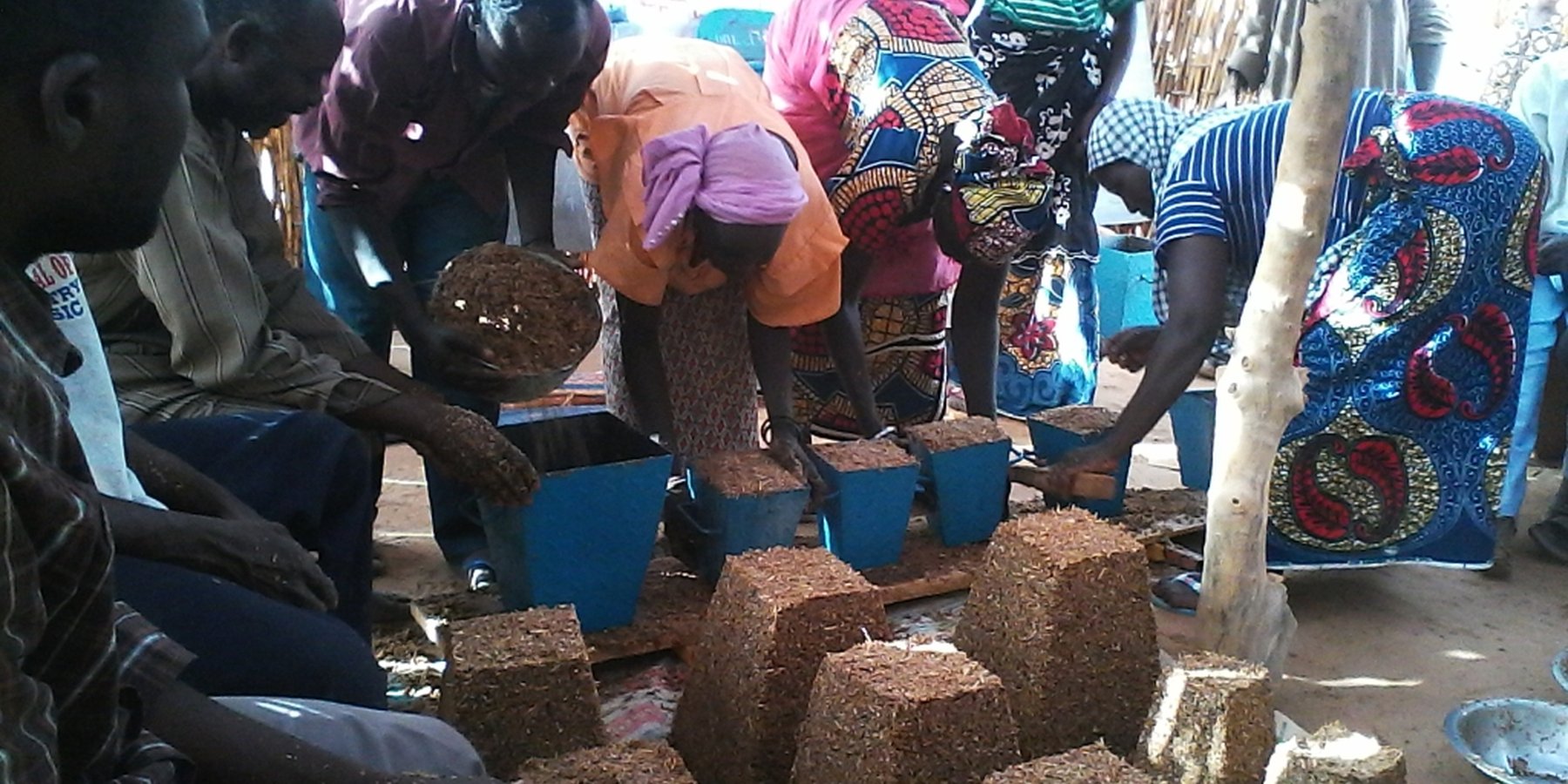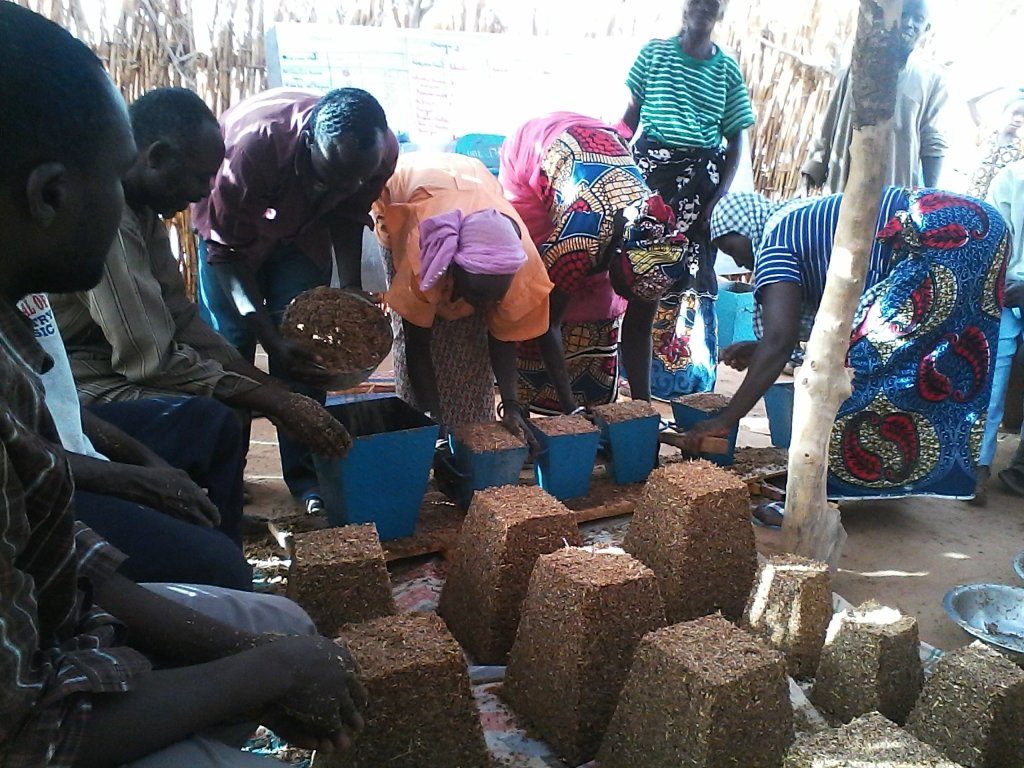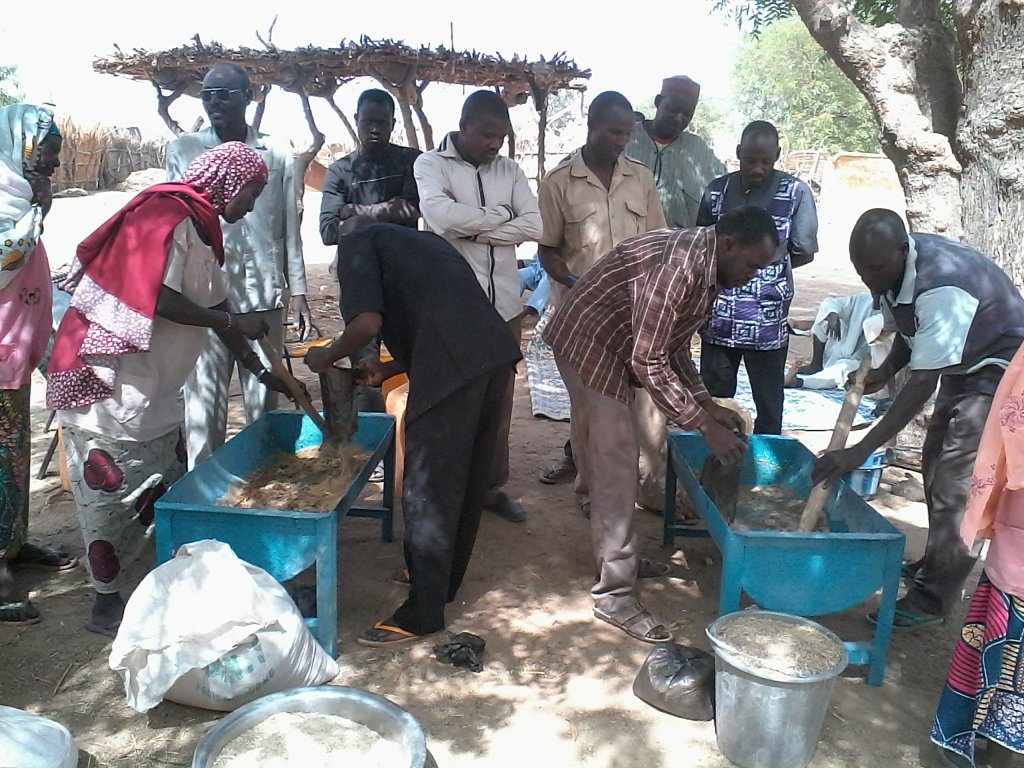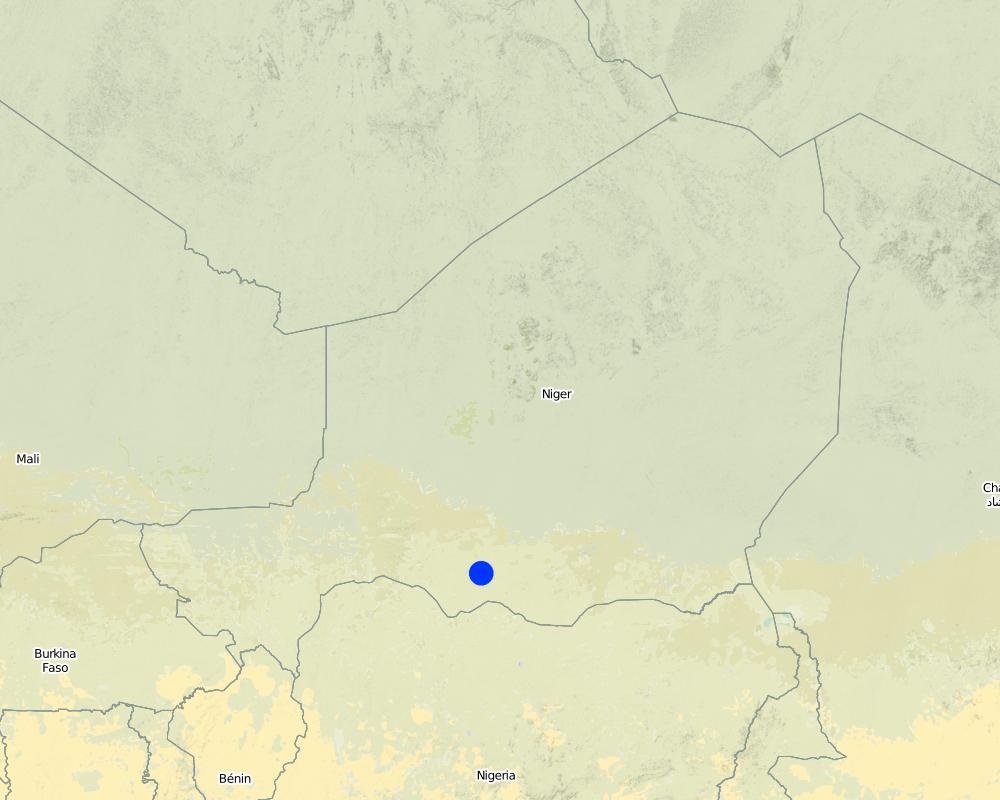Multi-Nutritional Fodder Blocks for livestock [Niger]
- Creation:
- Update:
- Compiler: Judith Macchi
- Editors: Abdourazak Bawa, Christine Lottje
- Reviewers: Alexandra Gavilano, David Beritault
Lassar Dabbobi
technologies_700 - Niger
View sections
Expand all Collapse all1. General information
1.2 Contact details of resource persons and institutions involved in the assessment and documentation of the Technology
Key resource person(s)
SLM specialist:
Abdourazak Bawa
arazakbawa@gmail.com
Name of project which facilitated the documentation/ evaluation of the Technology (if relevant)
Book project: where people and their land are safer - A Compendium of Good Practices in Disaster Risk Reduction (DRR) (where people and their land are safer)Name of the institution(s) which facilitated the documentation/ evaluation of the Technology (if relevant)
HEKS (Hilfswerk der Evangelischen Kirchen Schweiz) (HEKS (Hilfswerk der Evangelischen Kirchen Schweiz)) - Switzerland1.3 Conditions regarding the use of data documented through WOCAT
When were the data compiled (in the field)?
12/10/2016
The compiler and key resource person(s) accept the conditions regarding the use of data documented through WOCAT:
Yes
1.4 Declaration on sustainability of the described Technology
Is the Technology described here problematic with regard to land degradation, so that it cannot be declared a sustainable land management technology?
No
1.5 Reference to Questionnaire(s) on SLM Approaches
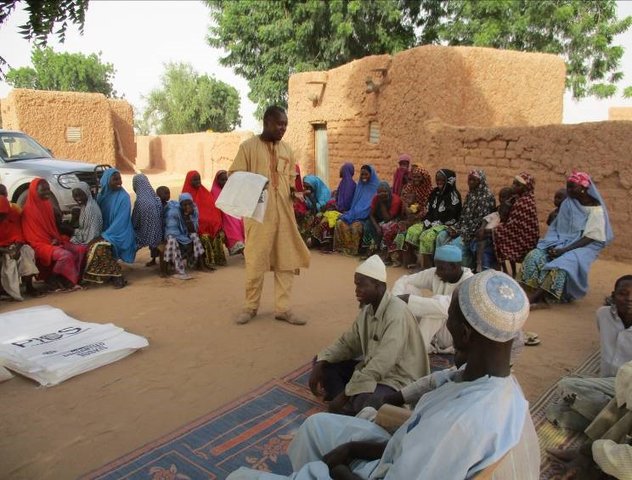
Training and awareness raising in the use of … [Niger]
This approach consists of disseminating improved agricultural techniques to increase the agricultural production. Producers are trained to demonstrate the techniques, and demonstration events are organised to make other producers aware of the use of these improved techniques.
- Compiler: Judith Macchi
2. Description of the SLM Technology
2.1 Short description of the Technology
Definition of the Technology:
Multi-Nutritional Blocks for livestock are an alternative animal feed for all seasons. They are a concentrate of nutritious elements prepared from crop residues such as stalks, pods, etc.
2.2 Detailed description of the Technology
Description:
Livestock rearing is the second biggest economic activity in Niger after farming. It substantially contributes to food security by providing substantial income to pastoralist households. However, due to the increasing pressure on grazing land because of recurrent drought and proceeding land degradation livestock rearing is becoming more and more difficult, which again accentuates the vulnerability of pastoralist households. The annual fodder balance for livestock, which is depending on the amount of rain, is regularly showing a deficit, thereby weakening the animal food security. Even though the animals consume not more than 30% of dry biomass, the supply is insufficient in most years, hence, the digestible nitrogen intake required for growth and the production of milk, and the requirements of vitamin A and E are not covered. Phosphorus is also an essential element for the metabolism, and must be supplied in sufficient quantity, because the deficiency of these elements in the food intake jeopardizes the survival of the animals. This necessitates to find food supplements which can raise the quality level of the animal feed.
Considering these rather critical and recurrent fodder deficits in Niger, the FAO, in collaboration with the National Agronomic Research Institute of Niger (INRAN), has initiated and tested the technique of the production of multi-nutritional fodder blocks . Agricultural by-products like stalks from millet, sorghum, maize or rice straw are crushed and mixed with micro-nutrients (phosphorus, salt), vitamins and binders (gum arabic, cement), and are compacted in a way that the product can be nibbled by herbivorous animals.
Sahelbio (financed by HEKS/EPER (Swiss Church Aid)) has taken on this technology in a project supporting the food security of rural households by agro-ecological intensification in the department of Mayahi. The production units for the blocks are located in the villages, and are managed by the village committees. The fodder blocks are produced in the form of pyramidal-shaped bricks, or in a form adapted to the needs of the households. The main equipment for producing the bricks includes shredders, mixture containers, molds, scales, and small tools and implements. The blocks are sold locally or at the markets, and thus constitute a source of additional income.
The fodder blocks constitute an alternative for the supplementary feeding of the animals in the period between harvests, or in years with critical fodder deficits. In this way, the blocks enable an increase of the milk and meat production, and the dependency on imported food decreases. Apart from the advantages for the animals, the technology offers the possibility to recover crop residues, while encouraging the population to engage in measures to maintain a vegetation cover (mobile fencing, storage of stalks, weed control, a.s.o.).
2.3 Photos of the Technology
2.5 Country/ region/ locations where the Technology has been applied and which are covered by this assessment
Country:
Niger
Region/ State/ Province:
Maradi
Further specification of location:
Mayahi
Comments:
The technology is applied in two other villages of the same department.
Map
×2.6 Date of implementation
Indicate year of implementation:
2014
2.7 Introduction of the Technology
Specify how the Technology was introduced:
- through projects/ external interventions
Comments (type of project, etc.):
The technology is introduced by a development project in cooperation with the producers.
3. Classification of the SLM Technology
3.1 Main purpose(s) of the Technology
- improve production
- adapt to climate change/ extremes and its impacts
- create beneficial economic impact
- Mitigate the livestock food crisis and improve the production and productivity of herbivores
3.2 Current land use type(s) where the Technology is applied

Cropland
- Annual cropping
Main crops (cash and food crops):
Millet, sorghum, groundnut, sesame
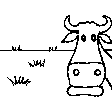
Grazing land
Extensive grazing land:
- Semi-nomadism/ pastoralism
Intensive grazing/ fodder production:
- Cut-and-carry/ zero grazing
Main animal species and products:
Goats, sheep, cattle, donkeys
3.3 Further information about land use
Water supply for the land on which the Technology is applied:
- rainfed
Comments:
Most of the ingredients (stalks, pods, fruits ...) are harvested after the rainy season.
Number of growing seasons per year:
- 1
3.4 SLM group to which the Technology belongs
- pastoralism and grazing land management
- integrated crop-livestock management
- improved plant varieties/ animal breeds
3.5 Spread of the Technology
Specify the spread of the Technology:
- evenly spread over an area
If the Technology is evenly spread over an area, indicate approximate area covered:
- 10-100 km2
Comments:
The technology is intended for livestock farmers, most of whom are pastoralists.
3.6 SLM measures comprising the Technology

vegetative measures
- V3: Clearing of vegetation

other measures
Comments:
This technology enables to recover crop residues while decreasing losses.
3.7 Main types of land degradation addressed by the Technology
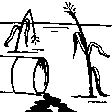
chemical soil deterioration
- Cn: fertility decline and reduced organic matter content (not caused by erosion)
Comments:
The animals enable that the soil is fertilised with manure.
3.8 Prevention, reduction, or restoration of land degradation
Specify the goal of the Technology with regard to land degradation:
- reduce land degradation
Comments:
The technology aims to provide a quality feed to the animals, which contribute in turn to the fertilisation of the soils through manure.
4. Technical specifications, implementation activities, inputs, and costs
4.1 Technical drawing of the Technology
4.2 Technical specifications/ explanations of technical drawing
The fodder blocks are fed to the animals in a trough in the form of pellets or crushed. The intake capacity of the blocks for grazing animals is 1.5 to 2 kg for the small adult ruminants (goats, sheep) and 7 to 10 kg for adult cattle per day.
4.3 General information regarding the calculation of inputs and costs
Specify how costs and inputs were calculated:
- per Technology unit
Specify unit:
per 20 kilogram of MNDB
other/ national currency (specify):
CFA franc
Indicate exchange rate from USD to local currency (if relevant): 1 USD =:
550.0
Indicate average wage cost of hired labour per day:
1000 CFA francs
4.4 Establishment activities
| Activity | Type of measure | Timing | |
|---|---|---|---|
| 1. | Shredding of stalks | Management | From December to May |
| 2. | Measurement of input quantities | Management | From December to May |
| 3. | Mixing of inputs in a container | Management | From December to May |
| 4. | Moulding of blocks | Management | From December to May |
| 5. | Drying of blocks | Management | From December to May |
| 6. | Sale | Other measures | From December to May |
4.5 Costs and inputs needed for establishment
| Specify input | Unit | Quantity | Costs per Unit | Total costs per input | % of costs borne by land users | |
|---|---|---|---|---|---|---|
| Labour | Production of blocks | person-days | 4.0 | 1000.0 | 4000.0 | 100.0 |
| Equipment | Shredder | 1.0 | 700.0 | 700.0 | ||
| Equipment | Bucket | 4.0 | 300.0 | 1200.0 | ||
| Equipment | Container | 2.0 | 800.0 | 1600.0 | ||
| Equipment | Mould | 1.0 | 400.0 | 400.0 | ||
| Equipment | Gas-oil | litre | 1.0 | 400.0 | 400.0 | |
| Equipment | Motor oil | litre | 1.0 | 300.0 | 300.0 | |
| Equipment | Mat | piece | 1.0 | 50.0 | 50.0 | |
| Plant material | Stalks of millet or sorghum | kg | 3.0 | 200.0 | 600.0 | 100.0 |
| Plant material | Cowpea tops | kg | 4.0 | 200.0 | 800.0 | 100.0 |
| Plant material | Bran | kg | 4.0 | 200.0 | 800.0 | 100.0 |
| Plant material | Salt | kg | 1.0 | 175.0 | 175.0 | 100.0 |
| Plant material | Acacia pods | kg | 1.0 | 150.0 | 150.0 | 100.0 |
| Plant material | Kalgo pods | kg | 1.0 | 150.0 | 150.0 | 100.0 |
| Plant material | Cement | kg | 1.0 | 125.0 | 125.0 | 100.0 |
| Plant material | Water | litre | 150.0 | 2.0 | 300.0 | 93.0 |
| Total costs for establishment of the Technology | 11750.0 | |||||
If land user bore less than 100% of costs, indicate who covered the remaining costs:
The project has financed the equipment.
Comments:
The costs refer to the manufacturing of 20 kg of fodder blocks.
4.6 Maintenance/ recurrent activities
| Activity | Type of measure | Timing/ frequency | |
|---|---|---|---|
| 1. | Shredding of stalks | Management | From December to May |
| 2. | Measurement of input quantities | Management | From December to May |
| 3. | Making of blocks | Management | From December to May |
| 4. | Mixing of inputs in a container | Management | From December to May |
| 5. | Moulding of blocks | Management | From December to May |
| 6. | Drying of blocks | Management | From December to May |
| 7. | Sale | Other measures | From December to May |
4.7 Costs and inputs needed for maintenance/ recurrent activities (per year)
| Specify input | Unit | Quantity | Costs per Unit | Total costs per input | % of costs borne by land users | |
|---|---|---|---|---|---|---|
| Labour | Production of blocks | person-days | 4.0 | 1000.0 | 4000.0 | 100.0 |
| Equipment | Gas-oil | litre | 1.0 | 400.0 | 400.0 | 100.0 |
| Plant material | Stalks of millet or sorghum | kg | 3.0 | 200.0 | 600.0 | 100.0 |
| Plant material | Cowpea tops | kg | 4.0 | 200.0 | 800.0 | 100.0 |
| Plant material | Bran | kg | 4.0 | 200.0 | 800.0 | 100.0 |
| Plant material | Salt | kg | 1.0 | 175.0 | 175.0 | 100.0 |
| Plant material | Acacia pods | kg | 1.0 | 150.0 | 150.0 | 100.0 |
| Plant material | Kalgo pods | kg | 1.0 | 150.0 | 150.0 | 100.0 |
| Plant material | Cement | kg | 1.0 | 125.0 | 125.0 | 100.0 |
| Plant material | Water | litre | 150.0 | 2.0 | 300.0 | 100.0 |
| Total costs for maintenance of the Technology | 7500.0 | |||||
Comments:
The annual cost depends on the production level.
4.8 Most important factors affecting the costs
Describe the most determinate factors affecting the costs:
Ingredients, diesel
5. Natural and human environment
5.1 Climate
Annual rainfall
- < 250 mm
- 251-500 mm
- 501-750 mm
- 751-1,000 mm
- 1,001-1,500 mm
- 1,501-2,000 mm
- 2,001-3,000 mm
- 3,001-4,000 mm
- > 4,000 mm
Specify average annual rainfall (if known), in mm:
250.00
Specifications/ comments on rainfall:
Rainy season from July to September
Indicate the name of the reference meteorological station considered:
Mayahi
Agro-climatic zone
- semi-arid
5.2 Topography
Slopes on average:
- flat (0-2%)
- gentle (3-5%)
- moderate (6-10%)
- rolling (11-15%)
- hilly (16-30%)
- steep (31-60%)
- very steep (>60%)
Landforms:
- plateau/plains
- ridges
- mountain slopes
- hill slopes
- footslopes
- valley floors
Altitudinal zone:
- 0-100 m a.s.l.
- 101-500 m a.s.l.
- 501-1,000 m a.s.l.
- 1,001-1,500 m a.s.l.
- 1,501-2,000 m a.s.l.
- 2,001-2,500 m a.s.l.
- 2,501-3,000 m a.s.l.
- 3,001-4,000 m a.s.l.
- > 4,000 m a.s.l.
Indicate if the Technology is specifically applied in:
- not relevant
5.3 Soils
Soil depth on average:
- very shallow (0-20 cm)
- shallow (21-50 cm)
- moderately deep (51-80 cm)
- deep (81-120 cm)
- very deep (> 120 cm)
Soil texture (topsoil):
- coarse/ light (sandy)
Soil texture (> 20 cm below surface):
- coarse/ light (sandy)
Topsoil organic matter:
- low (<1%)
5.4 Water availability and quality
Ground water table:
5-50 m
Availability of surface water:
poor/ none
Water quality (untreated):
poor drinking water (treatment required)
Is water salinity a problem?
No
Is flooding of the area occurring?
No
5.5 Biodiversity
Species diversity:
- low
Habitat diversity:
- low
5.6 Characteristics of land users applying the Technology
Sedentary or nomadic:
- Sedentary
Market orientation of production system:
- mixed (subsistence/ commercial
Off-farm income:
- less than 10% of all income
Relative level of wealth:
- very poor
Individuals or groups:
- individual/ household
Level of mechanization:
- manual work
Gender:
- women
- men
Age of land users:
- youth
- middle-aged
Indicate other relevant characteristics of the land users:
Predominantly illiterate
5.7 Average area of land owned or leased by land users applying the Technology
- < 0.5 ha
- 0.5-1 ha
- 1-2 ha
- 2-5 ha
- 5-15 ha
- 15-50 ha
- 50-100 ha
- 100-500 ha
- 500-1,000 ha
- 1,000-10,000 ha
- > 10,000 ha
Is this considered small-, medium- or large-scale (referring to local context)?
- medium-scale
5.8 Land ownership, land use rights, and water use rights
Land ownership:
- individual, not titled
Land use rights:
- individual
Water use rights:
- communal (organized)
Comments:
Access to land is through inheritance, purchase or pawning.
5.9 Access to services and infrastructure
health:
- poor
- moderate
- good
education:
- poor
- moderate
- good
technical assistance:
- poor
- moderate
- good
employment (e.g. off-farm):
- poor
- moderate
- good
markets:
- poor
- moderate
- good
energy:
- poor
- moderate
- good
roads and transport:
- poor
- moderate
- good
drinking water and sanitation:
- poor
- moderate
- good
financial services:
- poor
- moderate
- good
6. Impacts and concluding statements
6.1 On-site impacts the Technology has shown
Socio-economic impacts
Production
fodder production
fodder quality
animal production
Income and costs
diversity of income sources
Socio-cultural impacts
food security/ self-sufficiency
SLM/ land degradation knowledge
situation of socially and economically disadvantaged groups
Ecological impacts
Climate and disaster risk reduction
drought impacts
6.3 Exposure and sensitivity of the Technology to gradual climate change and climate-related extremes/ disasters (as perceived by land users)
Gradual climate change
Gradual climate change
| Season | Type of climatic change/ extreme | How does the Technology cope with it? | |
|---|---|---|---|
| seasonal temperature | dry season | increase | very well |
| other gradual climate change | variability of the rainfall (increase of extreme rainfall events, anomalies between the seasons) | increase | very well |
Climate-related extremes (disasters)
Climatological disasters
| How does the Technology cope with it? | |
|---|---|
| drought | very well |
6.4 Cost-benefit analysis
How do the benefits compare with the establishment costs (from land users’ perspective)?
Short-term returns:
positive
Long-term returns:
very positive
How do the benefits compare with the maintenance/ recurrent costs (from land users' perspective)?
Short-term returns:
positive
Long-term returns:
positive
6.5 Adoption of the Technology
- 10-50%
Of all those who have adopted the Technology, how many have did so spontaneously, i.e. without receiving any material incentives/ payments?
- 0-10%
Comments:
The implementation of the technology requires sizeable assets like shredders, which are not easy to realise in a rural environment where means of subsistence are often lacking.
6.6 Adaptation
Has the Technology been modified recently to adapt to changing conditions?
No
6.7 Strengths/ advantages/ opportunities of the Technology
| Strengths/ advantages/ opportunities in the land user’s view |
|---|
|
Increase of livestock production (breeding, milk, meat...); This technology enables to generate income. |
| The livestock has a higher value; |
| This technology enables to generate income. |
| Strengths/ advantages/ opportunities in the compiler’s or other key resource person’s view |
|---|
|
Transfer of skills; |
| Tackling food insecurity through the quality of food supply; |
| Improvement of the living standard of the producers. |
6.8 Weaknesses/ disadvantages/ risks of the Technology and ways of overcoming them
| Weaknesses/ disadvantages/ risks in the land user’s view | How can they be overcome? |
|---|---|
|
Sales difficulties, lack of entrepreneurial spirit |
Establishment of a marketing mechanism; |
| The large sensitivity of the fodder blocks to fungi | Optimal drying of the products |
| Weaknesses/ disadvantages/ risks in the compiler’s or other key resource person’s view | How can they be overcome? |
|---|---|
|
Low production |
Command of commercial technologies and good coverage of local markets |
7. References and links
7.1 Methods/ sources of information
- field visits, field surveys
10
- interviews with land users
10
- interviews with SLM specialists/ experts
2
- compilation from reports and other existing documentation
5
7.3 Links to relevant information which is available online
Title/ description:
Boosting agricultural production to prevent food crises
URL:
http://www.fao.org/fileadmin/user_upload/emergencies/docs/Niger_ERCU_Bulletin_1.pdf
Title/ description:
Niger: multi-nutritional densified blocks for livestock
URL:
http://www.waapp-ppaao.org/sites/default/files/fiche_bmn_2.pdf
Title/ description:
THE TECHNOLOGY OF MULTI-NUTRITIONAL BLOCKS IN NIGER
URL:
https://www.youtube.com/watch?v=MH7qfQnFuYE
Links and modules
Expand all Collapse allLinks

Training and awareness raising in the use of … [Niger]
This approach consists of disseminating improved agricultural techniques to increase the agricultural production. Producers are trained to demonstrate the techniques, and demonstration events are organised to make other producers aware of the use of these improved techniques.
- Compiler: Judith Macchi
Modules
No modules


